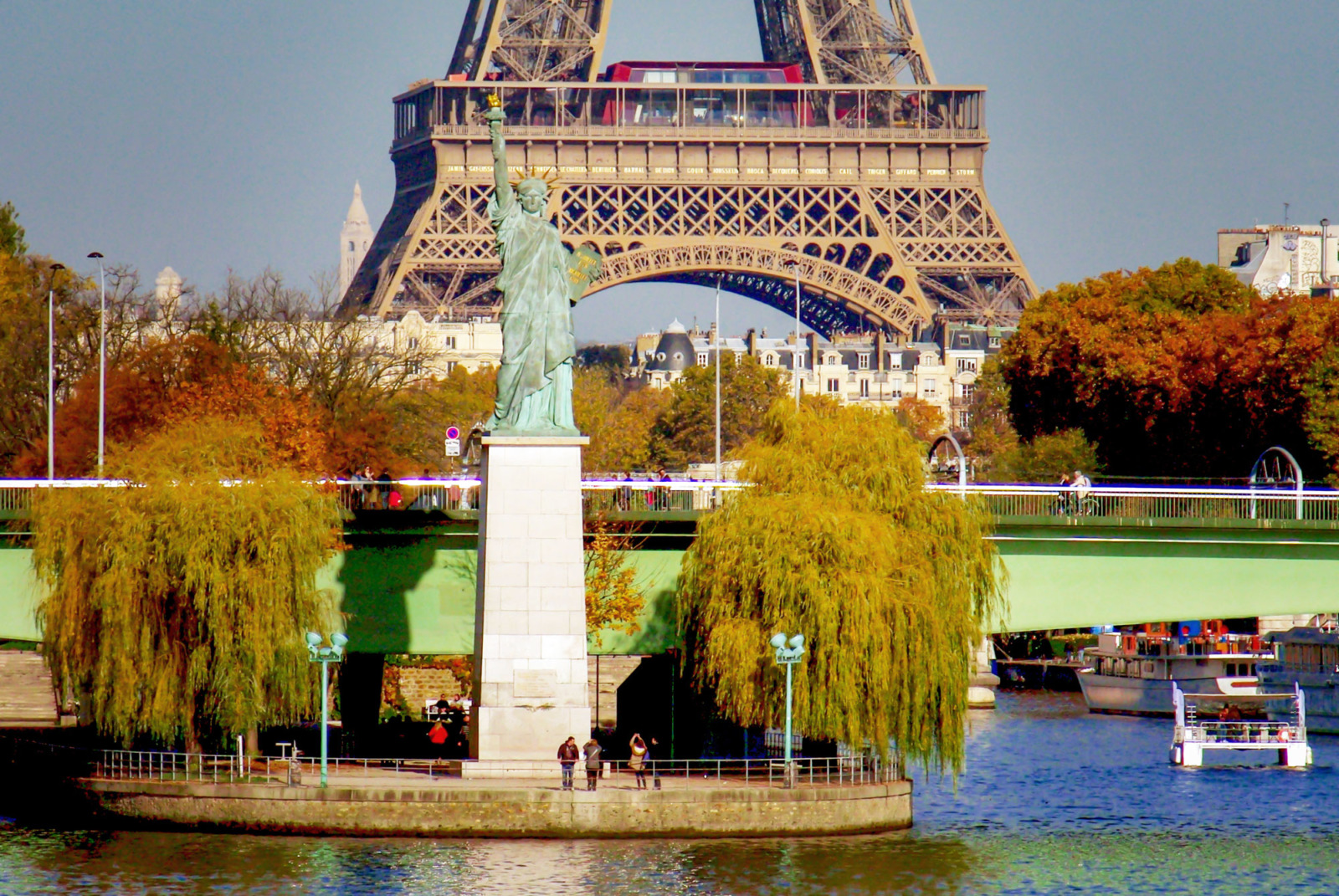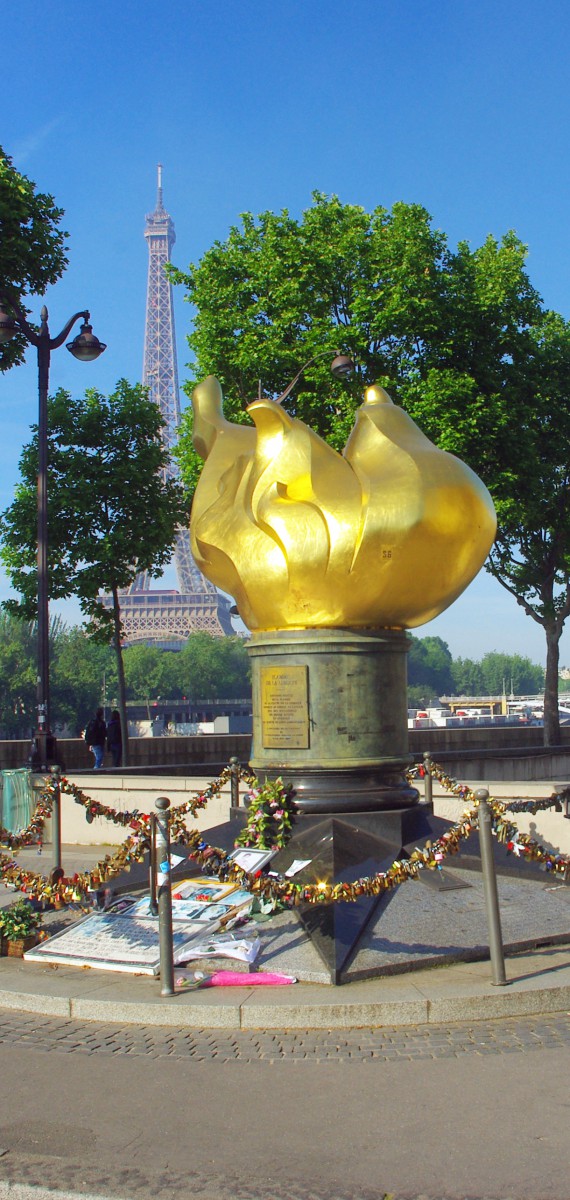Many people visiting the Flame of Liberty at Place Diana in Paris think it was built in memory of Princess Diana.
I used to think that too.
After all, it stands just above the tunnel where her car crashed on that fateful night in 1997.
But the truth is more complex — and more powerful.
This article takes you through the unexpected transformation of a diplomatic sculpture into one of the most emotional places of remembrance in Paris.
Along the way, I share personal memories and the moving story of how Place Diana came to be.
Place Diana: A Flame That Wasn’t Meant for Her
The first time I saw it, I was convinced it had been built for Diana.
There it stood—this golden flame rising above the traffic, encircled by love locks, handwritten notes, and fading snapshots of the Princess of Wales.

The setting was so peculiar, so striking, that I instinctively assumed the sculpture was a tribute to her.
It overlooked the tunnel where her car crashed.
It even looked like something out of Candle in the Wind.
What else could it be?
I wasn’t alone.
For years, thousands of tourists—maybe millions—have stopped here, by chance or design, to snap a photo, leave a flower, whisper a memory. Some kneel quietly.
Others smile for the camera, not realising this torch wasn’t meant for her at all.
And yet, somehow, it became hers.
This is the story of a monument that changed meaning without ever changing form.
A story of how history, grief, and public emotion collided on the banks of the Seine—and how a traffic-heavy Parisian roundabout became one of the city’s most unexpected places of pilgrimage.

The Place de l’Alma – A Monumental Crossroads
At first glance, the Place de l’Alma doesn’t look like the kind of place where memories cling.
It’s noisy. Brutal, even.

A great wheeled tide of cars flows through it day and night, funnelling from the grand avenues of Paris—George V, Montaigne, New York, Albert I—down into the shadows of the underpass.
The Seine glistens nearby.
The Eiffel Tower rises above it all like a sentinel.
And yet here, right at this intersection of glamour and chaos, sits one of the city’s most oddly sacred spots.

The square was created in 1858 and named after the Battle of the Alma, a Crimean War victory won by French and British troops.
It’s a classic Parisian roundabout: stone, symmetry, and relentless motion.
For decades, it was simply a point on the map—a place to pass through, not to pause.
And then, everything changed.

A Gift from America – The Story of the Flame
Before it became a shrine, the golden torch was just that: a golden torch.
It arrived in Paris in the late 1980s as a replica of the Statue of Liberty’s flame.

Sculpted in the U.S., funded by global donations, and inaugurated in 1989 by Jacques Chirac, it was meant to symbolise the enduring friendship between France and America.
A thank-you, in part, for the French craftsmanship that had restored the original statue in New York.
The sculpture stands 3.5 metres high, its copper flame gilded in gold leaf and mounted on a grey-and-black marble pedestal.
If you crouch down, you’ll find a plaque at the base:
“The Flame of Liberty. An exact replica of the Statue of Liberty’s flame, offered to the people of France by donors throughout the world as a symbol of the Franco-American friendship. On the occasion of the centennial of the International Herald Tribune. Paris 1887–1987.”

Nothing about Diana. Nothing British. Nothing tragic.
And yet…
31 August 1997 – The Night That Changed Everything
It was just past midnight when Diana’s Mercedes left the Ritz Hotel by the back entrance of Place Vendôme.
The car sped across Place de la Concorde, along the Cours la Reine, and into the Alma underpass.

Just before 12:23 a.m., it struck the 13th pillar at high speed.
Within minutes, the world would never see her again.
She was taken to the Pitié-Salpêtrière hospital but died two hours later.
The news broke before sunrise.
My wife Rachel was living in Paris at the time, working as a young fille au pair.
She remembers waking up to the sound of her host family gasping in shock.
“It felt unreal,” she later told me. “Not just because Diana had died, but because it had happened right here, in Paris, under the street I’d walked on so many times. She was someone my mum admired, and someone I really looked up to. It just didn’t seem possible.”
Back in England, my future mother-in-law—whose name, oddly enough, is also Diana—made the trip from Portsmouth to Kensington Palace to lay flowers.
The pile of bouquets, it’s said, reached five feet deep.
It was a wave of grief so intense, so global, it needed a place to land.
It found the Flame.

Place Diana: A Spontaneous Shrine
By dawn, the Flame of Liberty was no longer just a diplomatic sculpture.
People arrived with armfuls of roses.
They taped messages and photos to the marble base.
They tied ribbons, left candles, and scribbled poems on the guard rail.
The chain around the pedestal was filled with padlocks.

Elton John’s tribute, Candle in the Wind, became the unofficial soundtrack to the place.
Suddenly, this golden torch wasn’t just reminiscent of Diana.
It was Diana.
Sociologists have called it a counter-monument, borrowing from James E. Young’s concept: a place not designed for remembrance, but adopted for it.
Others describe it as a fictional tomb—a symbolic grave for someone whose real resting place lies far away.
Diana’s body, after all, is buried on an island at Althorp, her family’s estate in Northamptonshire.
But here, on this square above the Seine, her memory lives on.

When I finally visited myself, I felt the strange pull of it too.
I knew the flame wasn’t technically about her.
But as I stood there, watching people whisper and weep, I realised the official meaning no longer mattered.
This wasn’t about geopolitics.
It was about grief.
Place Diana: From Maria Callas to the Princess of Wales
A curious thing happened in the days before the crash.
The Paris city council had just approved a name for this part of the Alma Square: Place Maria-Callas.
The inauguration was planned for 11 September 1997 to mark the 20th anniversary of the soprano’s death.
But Diana died on 31 August.
And by the time officials arrived with their speeches and plaques, the square had been transformed by the people.
The mayor at the time, Jean Tiberi, quietly cancelled the ceremony.
Officially, it remained Place Maria-Callas.
But no sign ever appeared. The name faded into limbo.
Years passed. The idea of renaming the square after Diana was floated, then shelved, reportedly due to opposition from the British royal family.
But the visitors kept coming.
The flowers kept blooming.
The photographs kept being taped to the flame.

Finally, in June 2019—22 years after her death—the name Place Diana was formally approved.
Today, the street sign is there for all to see, easily photographed with the Eiffel Tower in the background.
Tourists stop, smile, sometimes cry.
Few know about Maria Callas.
Fewer still know the flame wasn’t meant for Diana.
But that doesn’t matter now.
Conclusion – Place Diana: A Memory That Outgrew Its Frame
Paris has many statues. Many plaques. Many places named after kings, queens, saints and soldiers.
But few spots feel as claimed by the people as this one.
The Flame of Liberty was supposed to be about France and America.
An international gesture.
A polished token of alliance.
Instead, it became something messier, more fragile, more human.
A public symbol twisted by grief into a private act of remembrance.
A flame no longer just of liberty, but of love and loss.
I still stop by when I’m in the area.
And every time, I notice something new: a single flower tucked between the bars, a candle flickering against the stone, a photo curling under the rain.
People still come. They still remember.
And that, more than any bronze plaque or mayoral speech, is what makes it sacred.

Read more about the Flame of Liberty at Place Diana.
The Place de l’Alma métro station is reached by line 9. Across the Pont de l’Alma is the RER C station Pont de l’Alma.
Did you enjoy what you read? If so, share this article on Facebook, X or Pinterest!
Pin this for later…





